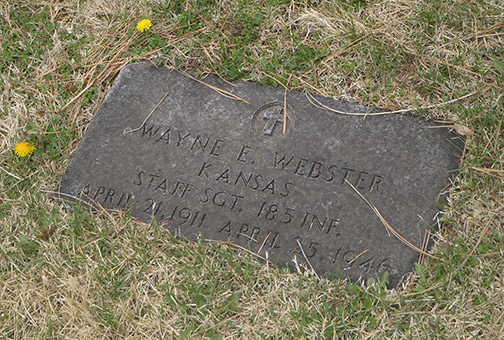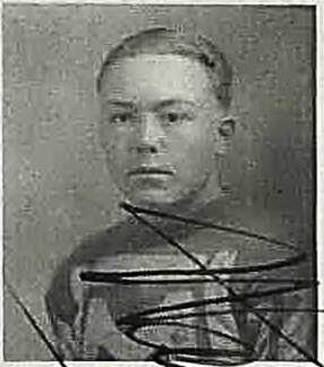Wayne E. Webster
Date of Birth: April 21, 1911
Place of Birth: Manhattan, Kansas
Father and Mother’s Names: Hall D. Webster and Florence Ethel (Embree) Webster
Date Entered Service: March 3, 1941 from Los Angeles, California.
Service Branch: Army National Guard
Rank/Specialty: Staff Sergeant
Service ID: 20904033
Division/Company/Unit info: Cannon Company, 185th Infantry, 2nd Battalion, 40th Division.
Awards and Commendations: Awarded the Good Conduct Medal December 14, 1943.
Riley Connection: Born on April 21, 1911 in Manhattan, Kansas. Graduated from Manhattan High School. From 1925-1930, Wayne and family lived at 321 Colorado St. in Manhattan.
Date of Death (and Age): March 25, 1946 (age 35)
Place of Death: Fitzsimon General Hospital, Denver, Denver Co., Colorado.
Grave Location: Sunset Cemetery, Manhattan, Kansas.
Bio: Wayne E. Webster was born on April 21, 1911 in Manhattan, Kansas to Hall D. Webster and Florence Ethel (Embree) Webster. Wayne's mother died when he was only 7 years old. His father re-married to Mabel J. Weber. There were no children born to this union. Wayne and his sister were raised in Manhattan. Wayne attended one year of college. By 1935, Wayne had been in the Navy. This fact was given on the 1940 Census where Wayne lived with his divorced sister, Dorothy, in Los Angeles, California. He was a Sheet Metal worker at an airplane factory. Wayne enlisted into the Army National Guard on March 3, 1941 at Los Angeles, California. He was 5' 9" tall and weighed 160 Lbs. Wayne was working as an electrician at the time he entered the military. Since he had one year of college under his belt he was given the rank of Corporal upon entry. Soon he became a Staff Sergeant attached to Cannon Company, 185th Infantry, 2nd Battalion, 40th Division. Wayne died on April 25, 1946 in a hospital in Denver, Colorado.
The 40th Infantry Division's march to battle in the Korean Conflict actually started five years earlier at the end of World War II. After fighting long and hard in the Pacific Theater, the Division was designated as one of the organizations to spearhead the invasion of Japan (Operation OLYMPIC), scheduled for November 1945. As General MacArthur’s spearhead, it was expected to receive a high-level of casualties, so it trained even harder to be ready for this task. However, after the dropping of the atomic bombs on Japan, they soon surrendered on August 15, 1945. Other than returning home, the 40th Infantry Division volunteered to free Korea from 40 years of occupation by Imperial Japan, and to help establish a democratic government. The XXIV Corps (6th, 7th, and 40th Infantry Divisions) started landing in Korea on September 8, 1945, with its commander who was also the United States Military Commander of South Korea Major General John R. Hodge. Within days, he reported… "Southern Korea can best be described as a powder keg ready to explode at the application of a spark [September 15, 1945].” Mainly composed of volunteers, the Division was well liked by the Korean citizens; credited for many humanitarian deeds; guarded the 38th Parallel from communist transgression; and started to help organize its constabulary defense force, whose core cadre had served in the Japanese Imperial Army. President Truman personally ordered that South Korea's military was only to be a small constabulary force; and forbid arming it with any heavy artillery, tanks, or fighter aircraft. At the same time in the North, the occupying Soviet Army that arrived on August 22, 1945, focused on building a large, highly indoctrinated, professional, and well-equipped military, armed with tanks, artillery, and aircraft. The core of the North’s army was composed of long time communist officers of the Korean Volunteer Army in China. By January 1946, the South had one battalion (1st Battalion, 1st Regiment of Korean Constabulary), when the North had a combat ready infantry division.
Over a month after World War II officially ended (March 3, 1946), the 40th Infantry Division, California National Guard, returned to California and finally demobilized on April 7, 1946 at Camp Stoneman, Pittsburg, California [near San Francisco]. Former Guardsmen of the 40th Infantry Division soon reformed their units in the California National Guard. Most units received Federal Recognition between September 1946 and March 1947. Most of these Guardsmen were battle hardened combat veterans, many having served in the National Guard before the war, many others serving both in the Pacific and European Theaters, and a few had been members since World War I. They knew what was required to prepare their units for combat.

